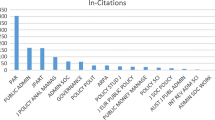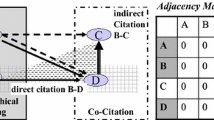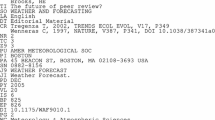Abstract
The study aims to assess journals’ structural influence in Internet research and uncover the impacts of network structures on journals’ structural influence drawing on theories of network closure and structural holes. The data of the study are the citation exchanges among 1,210 journals in Communication and other seven social scientific fields (i.e., Business, Economics/Finance, Education, Information Science, Political Science, Psychology, and Sociology) in Internet research. The top two most influential journals in Internet research are American Economic Review and Journal of Personality and Social Psychology. Journals in “Communication” field emerge to be an important source of influence in Internet research, whose mean structural influence ranks third among the eight fields, below “Business” and “Economics/Finance”, but above other five fields. Journals’ structural influences are found to grow over time and the growth rates vary across journals. Network brokerage is found to exert a significant impact on journals’ structural influence, while the impact of network closure on journals’ structural influences is not significant. The impact of network brokerage on journals’ structural influence will increase over time.




Similar content being viewed by others
Notes
These 13 subject categories include “Business”, “Business, Finance”, “Communication”, “Economics”, “Education and Education Research”, “Education, Special”, “Information Science and Library Science”, “Management”, “Political Science”, “Psychology, Applied”, “Psychology, Social”, “Sociology”, and “Psychology, Multidisciplinary”. “Fortune” and “Forbes” are excluded in the study as they are considered more as popular magazines rather than scholarly journals. “Science” and “Nature” are included in the list as they are considered as two prominent flagship journals by the general scientific community.
Three query words (i.e., Internet, web, and cyberspace/cyber-space) were used to search titles/abstracts/keywords of Internet-relevant articles from 2000 to 2010. Article language was limited to English, and document type was limited to scholarly journal articles.
Specifically, out of 1,413 journals listed in 13 subject categories, 871 (61.6 %) journals published Internet studies and were cited by Internet studies, 293 (20.7 %) were only cited in Internet studies without any Internet studies published, 46 (3.3 %) only published Internet studies with any citations received, and 203 (14.4 %) didn’t publish Internet studies and were not cited by Internet studies.
Clauset et al. (2009) combines maximum-likelihood fitting methods with goodness-of-fit tests based on the Kolmogorov–Smirnov statistic and likelihood ratios to discern and quantify power-law behavior in empirical data. First, power-law models are fitted to the observed long-tail distributions of in-degree/out-degree. Two coefficients are estimated for both distributions: scaling parameters α and lower bound on the scaling region x min (in-degree distribution: α = 1.77, x min = 46; out-degree distribution: α = 1.93, x min = 97). Then, goodness-of-fit tests are performed to tell whether the power-law model is a good match to the data or not. It turns out that the power-law model is a poor fit for both distributions (p < 0.001).
Spearman rank-order correlation between in-degrees and out-degrees is 0.56 (p < 0.001).
The average clustering coefficient for the random network is 0.027.
HLM outperforms traditional approaches (e.g., repeated ANOVA, MANOVA) in analyzing longitudinal data in several aspects, such as decomposition of fixed and random effects, treatment of time predictor, and inclusion of time-variant predictors (for a detailed discussion of HLM for longitudinal data, please refer to Raudenbush 2001; Hedeker 2004; Peugh and Enders 2005).
In educational research, ICC with cross-sectional design generally ranges between 0.05 and 0.20 (Snijders and Bosker 1999). The high ICC from the study is due to the longitudinal nature of the data, as ICC is also a measure of the average autocorrelation of the outcome variable over time (Singer and Willett 2003; Kwok et al. 2008).
Technically, four conditional linear growth models are estimated with four blocks of variables (i.e., control variables, network brokerage variables, network closure variables, and interaction terms) added to the model in a stepwise way.
References
Abbasi, A., Altmann, J., & Hossain, L. (2011). Identifying the effects of co-authorship networks on the performance of scholars: A correlation and regression analysis of performance measures and social network analysis measures. Journal of Informetrics, 5(4), 594–607.
Abbasi, A., Chung, K. S. K., & Hossain, L. (2012a). Egocentric analysis of co-authorship network structure, position and performance. Information Processing and Management, 48(4), 671–679.
Abbasi, A., Hossain, L., & Leydesdorff, L. (2012b). Betweenness centrality as a driver of preferential attachment in the evolution of research collaboration networks. Journal of Informetrics, 6, 403–412.
Ahuja, G. (2000). Collaboration networks, structural holes, and innovation: A longitudinal study. Administrative Science Quarterly, 45(3), 425–455.
Amsterdamska, O., & Leydesdorff, L. (1989). Citations: Indicators of significance? Scientometrics, 15, 449–471.
Barabasi, A. L., & Albert, R. (1999). Emergence of scaling in random networks. Science, 286(5439), 509–512.
Baron, N. S. (2005). Who wants to be a discipline? Information Society, 21(4), 269–271.
Baumgartner, H., & Pieters, R. (2003). The structural influence of marketing journals: A citation analysis of the discipline and its subareas over time. Journal of Marketing, 67(2), 123–139.
Berg, S., Duncan, J., & Friedman, P. (1982). Joint venture and corporate innovation. Cambridge, MA: Oelgeschlager, Gunn and Hain.
Borgatti, S. P. (1995). Centrality and aids. Connections, 18(1), 112–114.
Bourdieu, P., & Wacquant, L. J. D. (1992). An invitation to reflexive sociology. Chicago: University of Chicago Press.
Brown, L. D., & Gardner, J. C. (1985). Using citation analysis to assess the impact of journals and articles on contemporary accounting research. Journal of Accounting Research, 23(1), 84–109.
Bryant, J., & Miron, D. (2004). Theory and research in mass communication. Journal of Communication, 54(4), 662–704.
Burt, R. S. (1992). Structural holes: The social structure of competition. Cambridge, MA: Harvard University Press.
Burt, R. S. (1997). The contingent value of social capital. Administrative Science Quarterly, 42(2), 339–365.
Burt, R. S. (2000). The network structure of social capital. Research in Organization Behavior, 22, 345–423.
Burt, R. S. (2001). Structural holes versus network closure as social capital. In N. Lin, K. Cook, & R. S. Burt (Eds.), Social capital: Theory and research (pp. 31–56). New York: Aldine de Gruyter.
Burt, R. S. (2004). Structural holes and good ideas. American Journal of Sociology, 110(2), 349–399.
Burt, R. S. (2005). Brokerage and closure: An introduction to social capital. Cambridge: Oxford University Press.
Burt, R. S. (2010). Neighbor networks. Oxford: Oxford University Press.
Clauset, A., Shalizi, C. R., & Newman, M. E. J. (2009). Power-law distributions in empirical data. Siam Review, 51(4), 661–703.
Cohen, J., Cohen, P., West, S. G., & Aiken, L. S. (2003). Applied multiple regression/correlation analysis for the behavioral sciences (3rd ed.). Mahwah, NJ: Erlbaum.
Coleman, J. S. (1988). Social capital in the creation of human capital. American Journal of Sociology, 94, S95–S120.
Cote, J. A., Leong, S. M., & Cote, J. (1991). Assessing the influence of journal of consumer research: A citation analysis. Journal of Consumer Research, 18, 402–410.
De Leeuw, J., & Kreft, I. G. G. (1995). Questioning multilevel methods. Journal of Educational and Behavioral Statistics, 20(2), 171–189.
Easley, D., & Kleinberg, J. (2010). Networks, crowds, and markets: Reasoning about a highly connected world. New York: Cambridge University Press.
Franceschet, M. (2012). The large-scale structure of journal citation networks. Journal of the American Society for Information Science and Technology, 63(4), 837–842.
Freeman, L. C. (1979). Centrality in social networks: Conceptual clarification. Social Networks, 1(3), 215–239.
Garfield, E. (1979). Citation indexing: Its theory and application in science, technology, and humanities. New York: Wiley.
Garfield, E. (2006). The history and meaning of the journal impact factor. Journal of the American Medical Association, 295, 90–93.
Gargiulo, M., & Benassi, M. (2000). Trapped in your own net? Network cohesion structural holes, and the adaptation of social capital. Organization Science, 11(2), 183–196.
Hedeker, D. (2004). An introduction to growth modeling. In D. Kaplan (Ed.), Quantitative methodology for the social sciences (pp. 215–234). Thousand Oaks, CA: Sage.
Hite, J. M., & Hesterly, W. S. (2001). The evolution of firm networks: From emergence to early growth of the firm. Strategic Management Journal, 22(3), 275–286.
Hox, J. (2002). Multilevel analysis: Techniques and applications. Mahwah, NJ: Erlbaum.
Jansen, D., von Gortz, R., & Heidler, R. (2010). Knowledge production and the structure of collaboration networks in two scientific fields. Scientometrics, 83(1), 219–241.
Johnson, J. L., & Podsakoff, P. M. (1994). Journal influence in the field of management: An analysis using Salancik’s index in a dependency network. Academy of Management Journal, 37(5), 1392–1407.
Kim, M. T. (1992). A comparison of 3 measures of journal status—influence weight, importance index, and measure of standing. Library & Information Science Research, 14(1), 75–96.
Klenk, N. L., Hickey, G. M., & MacLellan, J. I. (2010). Evaluating the social capital accrued in large research networks: The case of the sustainable forest management network (1995–2009). Social Studies of Science, 40(6), 931–960.
Kwok, O. M., Underhill, A. T., Berry, J. W., Luo, W., Elliott, T. R., & Yoon, M. (2008). Analyzing longitudinal data with multilevel models: An example with individuals living with lower extremity intra-articular fractures. Rehabilitation Psychology, 53(3), 370–386.
Leibowitz, S. J., & Palmer, J. P. (1984). Assessing the relative impacts of economic journals. Journal of Economic Literature, 22, 77–88.
Leydesdorff, L. (2003). Can networks of journal–journal citations be used as indicators of change in the social sciences? Journal of Documentation, 59(1), 84–104.
Milgram, S. (1967). The small world problem. Psychology Today, 1(1), 60–67.
Moed, H. F., & Van Leeuwen, T. N. (1996). Impact factors can mislead. Nature, 381, 186.
Moed, H. F., Van Leeuwen, T. N., & Reedijk, J. (1999). Towards appropriate indicators of journal impact. Scientometrics, 46(3), 575–589.
Oh, W., Choi, J. N., & Kim, K. (2005). Coauthorship dynamics and knowledge capital: The patterns of cross-disciplinary collaboration in information systems research. Journal of Management Information Systems, 22(3), 265–292.
Peng, T. Q., & Zhu, J. J. H. (2012). Where you publish matters most: A multi-level analysis of factors affecting citations of internet studies. Journal of the American Society for Information Science and Technology, 63(9), 1789–1803.
Peng, T. Q., Zhang, L., Zhong, Z.-J., & Zhu, J. J. H. (2013). Mapping the landscape of internet studies: Text mining of social science journal articles 2000–2009. New Media & Society,. doi:10.1177/1461444812462846.
Peugh, J. L., & Enders, C. K. (2005). Using the SPSS mixed procedure to fit cross-sectional and longitudinal multilevel models. Educational and Psychological Measurement, 65(5), 717–741.
Podolny, J. M. (2001). Networks as the pipes and prisms of the market. American Journal of Sociology, 107(1), 33–60.
Putnam, R. D. (1993). Making democracy work. Princeton, NJ: Princeton University Press.
Raudenbush, S. W. (2001). Comparing personal trajectories and drawing causal inferences from longitudinal data. Annual Review of Psychology, 52, 501–525.
Reagans, R., & McEvily, B. (2003). Network structure and knowledge transfer: The effects of cohesion and range. Administrative Science Quarterly, 48(2), 240–267.
Reagans, R., & Zuckerman, E. W. (2001). Networks, diversity, and productivity: The social capital of corporate R&D teams. Organization Science, 12(4), 502–517.
Rowley, T., Behrens, D., & Krackhardt, D. (2000). Redundant governance structures: An analysis of structural and relational embeddedness in the steel and semiconductor industries. Strategic Management Journal, 21(3), 369–386.
Salancik, G. R. (1986). An index of subgroup influence in dependency networks. Administrative Science Quarterly, 31(2), 194–211.
Singer, J. D., & Willett, J. B. (2003). Applied longitudinal data analysis. New York: Oxford Press.
Snijders, T., & Bosker, R. (1999). Multilevel analysis: An introduction to basic and advanced multilevel modeling. London: Sage.
SPSS. (2005). Linear mixed-effects modeling in SPSS: An introduction to the mixed procedure. Retrieved from http://www.spss.ch/upload/1126184451_Linear%20Mixed%20Effects%20Modeling%20in%20SPSS.pdf.
Stovel, K., & Shaw, L. (2012). Brokerage. Annual Review of Sociology, 38(1), 139–158.
van Campenhout, G., van Caneghem, T., & van Uytbergen, S. (2008). A comparison of overall and sub-area journal influence: The case of the accounting literature. Scientometrics, 77(1), 61–90.
Wang, J. C., Chiang, C. H., & Lin, S. W. (2010). Network structure of innovation: Can brokerage or closure predict patent quality? Scientometrics, 84(3), 735–748.
Watts, D. J., & Strogatz, S. H. (1998). Collective dynamics of ‘small-world’ networks. Nature, 393(6684), 440–442.
White, D. R., & Borgatti, S. P. (1994). Betweenness centrality measures for directed graph. Social Networks, 16, 335–346.
Zhang, X., & Wang, C. (2012). Network positions and contributions to online public goods: The case of Chinese Wikipedia. Journal of Management Information Systems, 29(2), 11–40.
Zhou, Y. B., Lv, L. Y., & Li, M. H. (2012). Quantifying the influence of scientists and their publications: Distinguishing between prestige and popularity. New Journal of Physics, 14, 1–17.
Acknowledgments
The study was supported in part by a GRF Grant (CityU154412) from the Hong Kong Research Grants Council.
Author information
Authors and Affiliations
Corresponding author
Rights and permissions
About this article
Cite this article
Peng, T.Q., Wang, ZZ. Network closure, brokerage, and structural influence of journals: a longitudinal study of journal citation network in Internet research (2000–2010). Scientometrics 97, 675–693 (2013). https://doi.org/10.1007/s11192-013-1012-x
Received:
Published:
Issue Date:
DOI: https://doi.org/10.1007/s11192-013-1012-x




